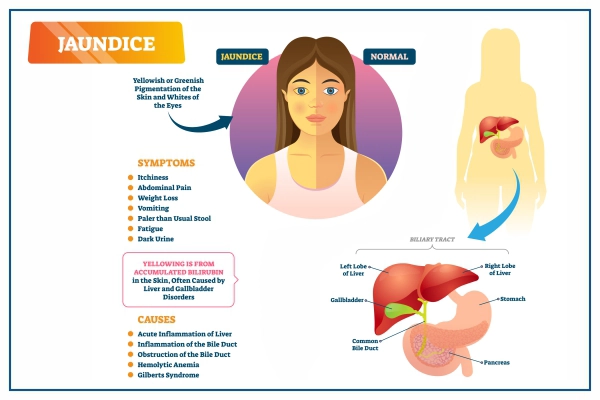Jaundice, also called hyperbilirubinemia, or icterus, is described as yellow discoloration of the body tissues such as the skin or white of the eyes (sclera) due to high bilirubin levels (a yellow-orange bile pigment) in the bloodstream.
Bilirubin is a yellow chemical pigment present in the hemoglobin. Bilirubin pigment is produced by the hemolysis (breakdown of red blood cells) in the body and it is excreted by the liver. But in the case of liver dysfunction, the pigment is not excreted and gets accumulated in the blood, giving rise to jaundice.
The normal bilirubin level in adults is - Direct bilirubin (also called conjugated)- 0 to 0.3 mg/dL
- Total bilirubin- 0.3 to 1.9 mg/dL
- Normal indirect bilirubin in newborns is under 5.2 mg/dL within the first 24 hours of birth.

Jaundice in Newborns
Neonatal jaundice or neonatal hyperbilirubinemia is a condition in which the total serum bilirubin (TSB) is increased in an infant and the skin, sclera, and mucous membrane appear yellow in color for the first few days of life.
Newborn jaundice that is mild, temporary, and self-limiting is called physiological jaundice. whereas the severe form is known as pathological jaundice.
Infant jaundice occurs because the baby’s liver takes a few days to remove bilirubin from the blood. This process was previously done by the mother's liver during pregnancy.
Jaundice Symptoms
The symptoms of jaundice include:
- The yellowish discolouration of the sclera (white area of the eye), or conjunctival icterus
- The skin tone appears yellow.
- The yellowish colour inside the mouth
- Urine colour is dark (bilirubinuria) or brown-colored.
- Stools are pale or clay-colored
- Bilirubin is a skin irritant; therefore, jaundice causes itching (pruritis).
- Yellow or green discolouration of teeth and dental hypoplasia in growing children.
- High fever
- Loss of appetite
- Stomach pain
- Loss of weight
- Vomiting
Types of jaundice
The types of jaundice are characterized by examining which part of the liver is malfunctioning and how it is affecting the excretion of bilirubin pigment from the blood circulation. The three major types of jaundice that can affect you are-
- Hepatocellular jaundice
- Hemolytic jaundice
- Obstructive jaundice
Causes of Jaundice
Jaundice, or icterus, is caused by the accumulation of high levels of bilirubin in the bloodstream.
As bilirubin is treated in the liver, jaundice is a manifestation of liver disorder. The various causes are:
- Viral infections like hepatitis A, B, C, D or E
- Liver cirrhosis or heavy alcohol consumption
- Autoimmune disorders - primary biliary cirrhosis
- Hereditary factors - Dubin–Johnson syndrome
- Specific medications include oral contraceptives, probenecid, chlorpromazine, rifampin, steroids, and herbal medications
- Pregnancy
- Gilbert syndrome
- Rotor syndrome
- Crigler–Najjar syndrome type 1 and 2
- Hyperthyroid
- Hepatic crisis in sickle cell disease
- Infiltrative diseases such as lymphoma, tuberculosis, amyloidosis, sarcoidosis
- Sepsis and hypoperfusion states
- Chronic liver disease
- Gallstones or gallbladder disorders cause bile duct blockage
- Blood disorders
- Pancreatic, gallbladder, liver cancer
- The jaundice of pregnancy
- Malaria
Risk Factors
- Excessive consumption of alcohol
- Using illicit medications
- Taking drugs that may damage the liver
- Exposure to viral infections like hepatitis A , hepatitis B , or hepatitis C
- Vulnerability to certain industrial chemicals
Diagnosis in infants
By doing physical examinations of the baby, pediatrics perform jaundice tests in babies. Newborns should be examined for jaundice every 8 to 12 hours during the first 48 hours of life and continue it till they are 5 days old. The infant bilirubin tests include -
- Light Meter: The pediatrician will use a light meter to check the transcutaneous bilirubin (TcB) level.
- Blood test: To check bilirubin levels and give accurate results.
Diagnosis in adults
By examining the jaundice signs and symptoms, the gastroenterologist can conclude the diagnosis.Other diagnosis options include:
- Blood tests: Various blood tests are used to diagnose jaundice, they are the complete blood count (CBC), liver function tests (LFT’s), etc.
- Imaging Tests: Ultrasonography of the abdomen, computerized tomography (CT) scan, magnetic resonance imaging (MRI), or other tests are done to monitor the flow of bile through the liver and also to check for any blockages.
- Liver biopsy: A liver biopsy is done to check for liver diseases
- Endoscopic Retrograde Cholangiopancreatography (ERCP): ERCP is a jaundice test done to diagnose and manage disorders pertaining to the liver, gallbladder, bile ducts, and pancreas.
- Laparoscopy (uncommon): This procedure is done to inspect the liver and gallbladder.
Jaundice Treatment
The treatment approach for it differs among newborns and adults. Also, based on every single condition and severity of the patient, the doctor adopts a more personalized treatment plan, which might vary in duration as well.
Jaundice treatment for infants
Mild jaundice subsides on its own after 1 or 2 weeks. Breastfeeding in infants should be done regularly. If the baby is not getting sufficient breast milk, the pediatrician may recommend supplementing with formula.
- Fluids: Giving fluids, as loss of fluids (dehydration) will cause high bilirubin levels.
- Phototherapy: It is a safe treatment procedure to cure newborn jaundice.
- Exchange blood transfusion: This procedure is preferred when there's no improvement. The high bilirubin levels do not come down even with phototherapy.
- Intravenous immunoglobulin (IVIg): IVIg stops antibodies targeting the red blood cells and decreases the need for an exchange transfusion.
Jaundice treatment for adults
Often, It doesn't require treatment in adults, but it is a serious condition in newborns. It can be treated for its underlying causes and effects. Treatment for jaundice is the management of the underlying hepatobiliary or hematological disease.
